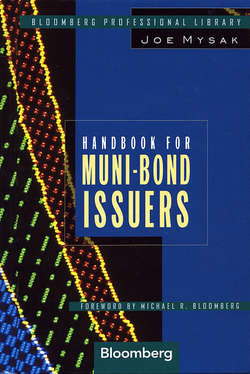Читать книгу Handbook for Muni-Bond Issuers - Mysak Joe - Страница 9
На сайте Литреса книга снята с продажи.
CHAPTER 1
GETTING STARTED
ОглавлениеMOST MUNICIPAL FINANCE officers have more in common with the director of finance whom I once called at home – only to be told that he was at work in the cranberry bog and would call me back later – than they do with Wisconsin’s full-time director of capital finance, or New York City’s comptroller.
Unlike these professionals, who have access not only to all of the analytical tools described later in this book, but also to professional staffs, most municipal finance officers find bond sales to be a very small (but irksome) part of the job. They represent a knotty problem that must be handled once every few years. With this in mind, let’s review the market basics.
First of all, there is no one thing called the “municipal market.” Those who generalize about such a thing (as in, “Hey, what about all these scandals roiling the municipal bond market?”) are unlikely to know what they are talking about.
The municipal market is an over-the-counter market, meaning that there is no organized central exchange where a bell goes off to signal the start and finish of the day’s trading. Buyers and sellers communicate and negotiate by telephone. If an investor and a broker agree on a transaction at midnight, that is the “municipal market” at that point in time.
Comparatively few of the millions of separate bonds outstanding, totaling more than $1.3 trillion at last count, actually trade at all. And more often than not, the prices of inactive securities are based on little more than a very educated guess.
What is a municipal bond? In simplest terms, it is an interest-bearing certificate issued by a government when it wants to borrow money. Most of today’s market is electronic, and comparatively few investors ever get to see the single representative paper “bond” held at a repository. A bond is a loan, unlike a share of stock, which represents ownership in a corporation. Stock-holders agree to ride out both good times and bad, including bankruptcy. Bondholders agree to loan money in return for interest and return of principal. This is why bonds are considered one of the most conservative investments.
Municipal bonds are singular and highly specific. The various characteristics that set each of them apart are far more numerous than the qualities they share. One analyst for a portfolio manager recently observed that there were more than 50 varieties of municipal bonds for him to study, and that was just a rough estimate.
The “municipal market” is highly fractured. Municipal market? There are highly evolved state-specific markets (California, Colorado, Florida, Illinois, New York, Texas); regional markets (the upper Midwest, the Deep South); and sector markets (health and hospital bonds, housing bonds, public power bonds, American Indian tribe financings, even high-yield bonds).
Most of the market is state specific. In other words, a Florida municipal bond firm might spend all its time dealing strictly with the issuers and buyers in its own state. It is not too far off the mark to say that, because of their independent, decentralized nature, nearly every state has a highly developed municipal bond market all its own. Comparatively few firms operate on a truly national basis. Those that do (the major Wall Street firms), typically deal with only the largest bond issues and issuers.
Most municipal bonds are relatively small. In 1996, more than $183 billion in municipal bonds were sold, but in more than 11,500 issues: The average size was approximately $15 million. And even this number is skewed higher by a relative handful of blockbuster deals. About 85 percent of the bonds sold each year are for an average of just over $5 million.
But the 80-20 rule also applies to municipal bond issuance: 80 percent of the actual number of bonds sold make up only about 20 percent of the dollar volume. These larger, more lucrative deals are the bond issues that Wall Street finds it worthwhile to chase. But in reality, small issuers just like yourself make up the bulk of the business. It is up to you to insist on the same level of service the larger issuers get in the big market.
Why do you sell bonds? For the same reasons that individuals take out loans. You, your municipality, does not have ready money at hand; or you find it more efficient to match up liabilities with the useful life of whatever it is you are paying for; or you think that a project’s users should also pay for it; or any one of a number of reasons.
Municipalities – and the term covers everything from a fire district, to an authority, on up to a state – today sell bonds for purposes ranging from repairing roads and bridges, to paying for sewer systems and mass transportation systems and even telecommunications systems, to funding pension liabilities, to building theme parks and sports stadiums and acquiring historic properties, to preserving farmland and beaches.
In a typical week, the municipal market handles 194 separate bond sales; the number rises to 250 or more in busy times and falls to 150 or less in a holiday-shortened week. In a typical week last year, as the York County, Pennsylvania Solid Waste and Refuse Authority was preparing to sell $114 million to refund bonds it had sold at higher interest rates back in 1985, Fergus Falls, Minnesota sold $6.6 million in general obligation bonds to fund various public improvements, and the Darlington, South Carolina School District sold $3.1 million to pay for school improvements.
Конец ознакомительного фрагмента. Купить книгу
